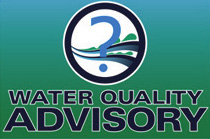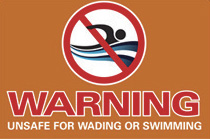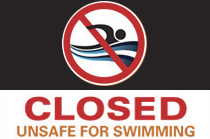About Blue-Green Algae Blooms
In the past few years, blue-green algae blooms have formed off the southwest region of Lake Erie near Pelee Island.
During a bloom, wind conditions may move the blue-green algae bloom towards the shores of Windsor-Essex County and Pelee Island, which could contaminate some sources of drinking water and beaches.
Residents and visitors are urged to take a cautious approach, monitor the situation, and protect themselves from potential health risks.
What are blue-green algae?
Blue-green algae (Cyanobacteria) are microscopic bacteria that occur naturally in freshwater lakes, ponds, rivers and streams in the late summer and early fall. In warm weather, with the right nutrients (phosphorous and nitrogen) and low wind, they can form a large mass called a bloom. These blooms can make the water appear bluish-green, can form solid looking clumps, and may contain toxins, called microcystins, that can be dangerous to your health and the health of your animals.
Fresh blue-green algal blooms often smell like fresh cut grass, while older blooms can smell like foul fecal matter. Older blooms are more likely to release toxins since their dying cells will produce a strong, foul odour.
Exposure to harmful microcystins poses a health risk to everyone, however, those most at risk for severe illness are children 6 years of age and younger and pets that swim in and/or drink contaminated water.
How can you be exposed?
- Direct skin contact (swimming).
- Swallowing (drinking water).
- Eating fish caught in water where blue-green algae blooms occur.
- Inhaling mist in the air containing blue green algae cells or toxins (e.g., waterskiing, showering).
What are the Health Effects?
Contact with microcystins can produce the following negative health effects:
Skin Contact
- Itchy, irritated eyes and skin if you swim, bathe, or shower in contaminated water.
Swallowed
- Small quantities - headaches, fever, diarrhea, abdominal pain, nausea, and vomiting.
- Large quantities - more serious health effects may occur such as liver damage.
Contact your health care provider if you have any of these symptoms.
Please note that infants and young children (under age 6) are most at risk of developing health problems (e.g., liver damage) from exposure to blue-green algae.
During a blue-green algae bloom, the following precautions are recommended:
- Do not boil or treat the water. Boiling or treating the water makes it more toxic.
- Do not drink water drawn from the affected water source.
- Ensure bottled water is used for all infant feeding preparation.
- Do not swim or play in affected water.
What’s being done to monitor for blue-green algae?
Organizations such as your Municipality, the Windsor-Essex County Health Unit, the Essex-Region Conservation Authority, the Ministry of Environment and Climate Change, etc., work together to monitor and test the water in the following ways:
- Visually monitor area lakes and waterways.
- Test the municipal drinking water systems.
- Monitor satellite images.
- Report results to the Health Unit.
- Issue advisories and warnings to the public as needed.
What if I suspect a blue-green algae bloom?
- Assume it is toxic
- DO NOT swim, drink, or bathe in the water
- Restrict pets and livestock from using the water
- Call the Ministry of the Environment and Climate Change’s Spills Action Centre at 1-866-MOE-TIPS (1-866-663-8477)
- Call WECHU to report it and for more information at 519-258-2146 ext. 4475
How can I help prevent the growth of blue-green algae?
- Use phosphate- free soaps, detergents and cleaning products.
- Avoid using lawn fertilizers, especially those that contain phosphorous.
- Ensure your septic tank is in good working condition and not leaking into the water.
- Maintain a natural shoreline on waterfront properties.
- Plant and maintain vegetation along waterways to reduce agricultural runoff.
Swimming Recommendations
Click the headings below for a description and recommended actions when there is a recreational water advisory, warning, or closure due to Blue-Green Algae:
Level of Microcystins - Parts per Billion (ppb)
1.5 ppb to 10 ppb
Description
The water appears cloudy, but you can still see your feet. Particle density can vary greatly.
Recommendations
- Swim with CAUTION and rinse off with clean water after swimming.
- DO NOT swim if the water looks cloudy, like green paint, or pea soup.
Sign Description
- This Advisory sign will be posted all year round on Pelee Island public beaches due to frequent blooms of Blue Green Algae.
- This Advisory sign will be posted at public beaches in Windsor- Essex County if BGA results reflect these levels.
Signage

Level of Microcystins - Parts per Billion (ppb)
10 ppb or higher
Description
There is a significant change in the cloudiness and colour, which may appear blue, green, brown, or red.
Algae may be in clusters or balls or flakes in the water, like pea soup.
Recommendations
- DO NOT swim
- DO NOT use this water for recreational use (e.g., boating, water skiing, etc.)
Sign Description
- This Warning sign will be posted on Pelee Island public beaches if BGA results reflect these levels.
Signage

Level of Microcystins - Parts per Billion (ppb)
20 ppb or higher (as per Health Canada, 2012)
Description
This is a dense bloom; it may resemble an oil or paint spill and the surface of the water may form a scum.
Water may have observable taste and odour that can be described as earthy-musty, grassy, septic, or foul fecal odour. Algae is easily swept by the wind and deposited near the shore.
Recommendations
- DO NOT swim
- DO NOT use this water for recreational use (e.g., boating, water skiing, etc.)
Sign Description
- This Closed sign will be posted at public beaches in Windsor- Essex County if BGA results reflect these levels.
Signage

Acceptable Levels of Microcystins
- Less than 10 ppb for safe recreational water quality.
Windsor-Essex County Health Unit as per Health Canada Guidelines (2020) - Less than 1.5 ppb for drinking water quality.
Ontario Drinking Water Quality Standard - Less than 0.3 ppb for drinking water quality for infants and young children under age 6.
United States Environmental Protection Agency (2015)
Drinking Water Recommendations
DO NOT BOIL THE WATER DURING A BLUE-GREEN ALGAE BLOOM!
Do not boil your water or manually treat the water with chlorine or other disinfectants. Boiling or treating the water makes it more toxic because it opens the cells and releases the bacteria’s toxin. A Boil Water Advisory (BWA) is never issued during a blue-green algae bloom; an alternate water source must be used.
Click the headings below for recommended actions based on Microcystins level:
Units are Parts per Billion (ppb).
United States Environmental Protection Agency, 2015
Recommendations if using a Well/ Cistern that draws water from Lake Erie (e.g., private cottages with a well)
- Health effects are unlikely at this stage, but toxins may still be present.
- Consider using test strips to determine if toxin is present in raw water (for example, Algal Toxin Test Strip Kits – eurofin-technologies.com) If you do not have a test strip or suspect a toxin is present, refer to precautions described below.
- DO NOT let infants and young children less than 6 years of age drink the water.
- DO NOT boil the water or add chlorine to the water. It will break down the bacteria and release more toxins into the water.
- Ensure only bottled water (that is boiled) is used for all infant feeding preparations.
Recommendations if using Municipal Drinking Water
- Water is safe to drink and use unless you are notified otherwise. Routine water testing is done by the municipal water treatment plant.
- The municipality will notify the public of any advisories or warnings based on test results.
Recommendations if using a Well/ Cistern that draws water from Lake Erie (e.g., private cottages with a well)
- DO NOT drink, cook with, rinse food with, brush your teeth, bathe or shower in this water (unless you are routinely testing for blue- green algae using a licensed lab and results show levels less than 1.5 ppb)
- Instead, use potable water from a safe alternative source. e.g. bottled water
- DO NOT boil the water or add chlorine to the water. It will break down the bacteria and release more toxins into the water.
- DO NOT rely on a jug filtration system, as it will not remove the toxins
Recommendations if using Municipal Drinking Water
- Water is safe to drink and use unless you are notified otherwise. Routine water testing is done by the municipal water treatment plant.
- The municipality will notify the public of any advisories or warnings based on test results.
Acceptable Levels of Microcystins
- Less than 10 ppb for safe recreational water quality.
Windsor-Essex County Health Unit as per Health Canada Guidelines (2020) - Less than 1.5 ppb for drinking water quality.
Ontario Drinking Water Quality Standard - Less than 0.3 ppb for drinking water quality for infants and young children under age 6.
United States Environmental Protection Agency (2015)
How Do I Prepare An Emergency Water Supply?
- Store at least a 3 day supply of water for your household (try to store a 2 week supply if possible).
- On average each person and pet uses at least 2 litres of water per day. You should consider storing more water for summer weather, for pregnant women, and for persons who are ill.
- Check the expiration date of store-bought water and replace stored water every 6 months.
What types of containers can I use for water storage?
A supply of unopened commercially bottled water is the safest and most reliable emergency water supply.
If you’re preparing stored water yourself, you should use food-grade water storage containers, such as those found at surplus or camping supply stores.
- Do not use containers that have been used for any toxic solid or liquid chemicals (e.g., old bleach containers).
- Do not use containers that cannot be sealed tightly.
- Do not use containers that can break, such as glass bottles.
- Do not use plastic or cardboard bottles, jugs, and containers used for milk or fruit juices.
How should I clean my storage containers?
Before filling with safe water, use these steps to clean and sanitize storage containers:
- Wash the storage container with dishwashing soap and water and rinse completely with clean water.
- Sanitize the container by adding a solution made by mixing 1 teaspoon of unscented liquid household chlorine bleach in 1 litre of water.
- Cover the container and shake it well so that the sanitizing bleach solution touches all inside surfaces of the container.
- Wait at least 30 seconds and then pour the sanitizing solution out of the container.
- Let the empty sanitized container air-dry before use OR rinse the empty container with clean, safe water that already is available.
Pets & Livestock
Protect your pets and livestock
Avoid letting pets and livestock animals drink or swim in water during a bloom as they may suffer serious health risks including death.
If they have come in contact with the water, rinse them off right away with clean water.
Call a veterinarian if your animal shows signs of illness after being in contact with water.
Fish Consumption
Use caution when considering eating fish caught in water affected by a major blue- green algae bloom. Eating these fish might make you sick.
It is recommended to avoid eating fish from waters during a blue- green algae bloom and for two weeks after the bloom.
Refer to the Guide to Eating Ontario Fish for more information.
References
- Centers for Disease Control and Prevention. (2020). Personal preparation and storage of safe water.
- Health Canada. (2020). Guidelines for Canadian drinking water quality: Guideline technical document – cyanobacterial toxins - Microcystin-LR.
- Health Canada. (2012). Guidelines for Canadian recreational water quality, 3rd edition.
- Ontario Ministry of the Environment, Conservation and Parks (2023). Guide to eating Ontario fish, 29th edition.
- Ontario Ministry of the Environment, Conservation and Parks (2014). Information about blue- green algae: Background, potential impacts to human health and safety of drinking water.
- United States Environmental Protection Agency. (2015). Recommendations for public waters systems to manage cyanotoxins in drinking water.
- World Health Organization. (2020). Cyanobacterial toxins: Microcystins. Background document for development of WHO Guidelines for drinking-water quality and Guidelines for safe recreational water environments.
For more information:
Blue-green algae - Ontario Ministry of the Environment, Conservation and Parks

